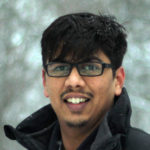joined the THREAD project in September 2020 (read his welcome message)
I am Sudhanva Kusuma Chandrashekhara and I am from India. I have a bachelor’s degree in Mechanical Engineering from Visveswaraya Technological University (India) and a master’s degree in Computational Science and Engineering from the University of Rostock (Germany).
A vast expanse of opportunities, enormous scope for research and innovation coupled with my personal interests in the field of Applied Mathematics led me to choose the area of Computational Science and Engineering. My master’s program had lots to offer in the areas of Computational Methods, Numerical Mathematics, analysis of PDE and at this point I started taking special interest in the areas of Linear Algebra and Finite Element Methods. Later these interests led me to take up software project and master thesis at the chair of wind energy technology. During these projects, I worked on developing finite element based solver for the calculation of natural frequencies of a wind turbine rotor blade using Euler Bernoulli and Timoshenko beam elements to investigate the effect of structural twist and prebending on 3D eigenmodes.
Soon after my master’s, my desire to explore newer areas started with a research fellowship in a DST- INSPIRE project at the Indian Institute of Technology, Delhi. The project aimed at low frequency vibration mitigation using periodic local resonators and I worked on developing solvers for the calculation of flexural band gaps (Bragg gap and Local resonant band gaps) for the linear periodic resonators and investigated the existence of flexural bandgaps at low frequency range. Further during the fall of 2019, I also had an opportunity to work in the field of high-speed aerodynamics and aerothermodynamic analysis. I worked on development of a heat conduction solver using finite volume method and coupling with the fluid flow solver for high speed flow application (Supersonic and Hypersonic).
Staying engaged in the field of Mathematical modelling and simulation, stimulated my interest and strengthened my desire to continue my doctoral research in the same field and this very fascination has brought me here as a Marie Curie Fellow on the THREAD project. I feel confident that given the inherent interdisciplinary and collaborative nature of the group; this opportunity will provide an excellent entry point towards an exciting research career.
Sudhanva Kusuma Chandrashekhara, September 2020

